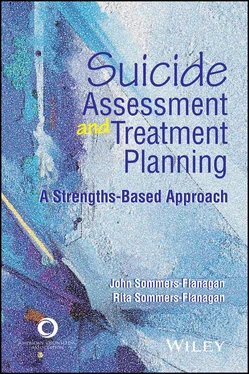John Sommers-Flanagan - Suicide Assessment and Treatment Planning
Здесь есть возможность читать онлайн «John Sommers-Flanagan - Suicide Assessment and Treatment Planning» — ознакомительный отрывок электронной книги совершенно бесплатно, а после прочтения отрывка купить полную версию. В некоторых случаях можно слушать аудио, скачать через торрент в формате fb2 и присутствует краткое содержание. Жанр: unrecognised, на английском языке. Описание произведения, (предисловие) а так же отзывы посетителей доступны на портале библиотеки ЛибКат.
- Название:Suicide Assessment and Treatment Planning
- Автор:
- Жанр:
- Год:неизвестен
- ISBN:нет данных
- Рейтинг книги:4 / 5. Голосов: 1
-
Избранное:Добавить в избранное
- Отзывы:
-
Ваша оценка:
- 80
- 1
- 2
- 3
- 4
- 5
Suicide Assessment and Treatment Planning: краткое содержание, описание и аннотация
Предлагаем к чтению аннотацию, описание, краткое содержание или предисловие (зависит от того, что написал сам автор книги «Suicide Assessment and Treatment Planning»). Если вы не нашли необходимую информацию о книге — напишите в комментариях, мы постараемся отыскать её.
Suicide Assessment and Treatment Planning — читать онлайн ознакомительный отрывок
Ниже представлен текст книги, разбитый по страницам. Система сохранения места последней прочитанной страницы, позволяет с удобством читать онлайн бесплатно книгу «Suicide Assessment and Treatment Planning», без необходимости каждый раз заново искать на чём Вы остановились. Поставьте закладку, и сможете в любой момент перейти на страницу, на которой закончили чтение.
Интервал:
Закладка:
Many other articles are available that focus on how counselors can deal with client suicides. We recommend that you explore this important area and find resources that fit your needs.
Postvention
Postvention is an essential component of dealing with completed suicides. The term postvention was first coined by Edwin Shneid-man in 1968 at the inaugural gathering of AAS. In 2017, the Psychopathology Committee of the Group for the Advancement for Psychiatry defined and articulated the rationale for suicide postvention: “Postvention, or how clinicians manage the postsuicide aftermath, strengthens suicide prevention, destigmatizes the tragedy, operationalizes the confusing aftermath, and promotes caregiver recovery” (Erlich et al., 2017, p. 507).
Although research on postvention is limited, many different postvention protocols and strategies have been developed. For instance, a 234-page document titled Coming Together to Care is available for download at www.texassuicideprevention.org/wp-content/uploads/2013/06/TexasSuicidePrevention-2012Toolkit_8-31.pdf. This document is a postvention toolkit developed in Texas by a consortium of organizations dedicated to suicide prevention.
Postvention is an underdeveloped pillar of suicide prevention (Maple et al., 2019). This is partly because postvention effects are notoriously difficult to assess. Given that every suicide and community or school context is unique, identifying a control group for postvention efficacy research is impossible. In one review of 16 published studies of high research quality, the researchers concluded, “No protective effect of any postvention program could be determined for number of suicide deaths or suicide attempts” (Szumilas & Kutcher, 2011, p. 18). However, “contact with a counseling postvention for familial survivors of suicide generally helped reduce psychological distress in the short term” (p. 18).
Nationally and internationally, beliefs vary regarding how much attention to give a death by suicide. Famous or infamous deaths by suicide get substantial press coverage, and sometimes this raises awareness of the problem. However, the tone of the coverage is influential. A group of 21 academic, community, and not-for-profit organizations published a checklist of dos and don’ts for media reporting on suicide. They recommend that media organizations avoid the following:
Running sensationalistic headlines
Including photos of the location, the method, grieving families, or memorials
Using terms like epidemic to describe suicide
Describing suicides as not explainable or as happening “without warning”
Quoting from suicide notes
Using crime investigation reporting styles
Quoting police or first responders on suicide causes
Referring to suicides as “committed,” “successful,” “unsuccessful,” or “failed” (this list is adapted from “Recommendations for Reporting on Suicide,” n.d.)
Although tragic, suicides are not the fault of loved ones, caregivers, schools, or law enforcement. The best postvention efforts do not level blame or sensationalize but rather encourage grieving, healing, and prevention. (The Suicide Prevention Resource Center has information on an array of suicide-related topics, including postvention, at https://www.sprc.org/news/postvention-prevention.)
Concluding Comments
Competency not only helps ensure that you are meeting professional standards and standards of ethical practice, it also helps reduce anxiety and relieve self-doubt. In this chapter, we summarized competencies for working with clients or students who are suicidal. Although the breadth and complexity of suicide-related competencies may feel overwhelming, as you progress through this book your confidence and comfort with suicide competencies will increase.
Practitioner Guidance and Key Points to Remember
Core suicide competencies, as described by Cramer and his colleagues (2013), include the following:
1 Be aware of and manage your attitude and reactions to suicide.
2 Develop and maintain a collaborative, empathic stance with clients.
3 Know and elicit evidence-based risk and protective factors.
4 Focus on current plan and intent of suicidal ideation.
5 Determine the level of risk.
6 Develop and enact a collaborative evidence-based treatment plan.
7 Notify and involve other persons.
8 Document risk assessment, the treatment plan, and the rationale for clinical decisions.
9 Know the law concerning suicide.
10 Engage in debriefing and self-care.
Along with suicide-related competencies, counselors also need to be well versed in ethical principles and practices associated with suicide assessment and treatment. In addition to knowing your agency’s or school’s policy and procedures on suicide, you must attend to key ethical issues, including (a) informed consent, (b) confidentiality and its limits, (c) social media policies, and (d) emergency procedures. Several topics specific to online or distance counseling platforms were also discussed in this chapter. Documenting, maintaining professional boundaries, dealing with client or student death by suicide, and engaging in postvention practices are part of functioning as an ethical professional.
Конец ознакомительного фрагмента.
Текст предоставлен ООО «ЛитРес».
Прочитайте эту книгу целиком, купив полную легальную версию на ЛитРес.
Безопасно оплатить книгу можно банковской картой Visa, MasterCard, Maestro, со счета мобильного телефона, с платежного терминала, в салоне МТС или Связной, через PayPal, WebMoney, Яндекс.Деньги, QIWI Кошелек, бонусными картами или другим удобным Вам способом.
Интервал:
Закладка:
Похожие книги на «Suicide Assessment and Treatment Planning»
Представляем Вашему вниманию похожие книги на «Suicide Assessment and Treatment Planning» списком для выбора. Мы отобрали схожую по названию и смыслу литературу в надежде предоставить читателям больше вариантов отыскать новые, интересные, ещё непрочитанные произведения.
Обсуждение, отзывы о книге «Suicide Assessment and Treatment Planning» и просто собственные мнения читателей. Оставьте ваши комментарии, напишите, что Вы думаете о произведении, его смысле или главных героях. Укажите что конкретно понравилось, а что нет, и почему Вы так считаете.











